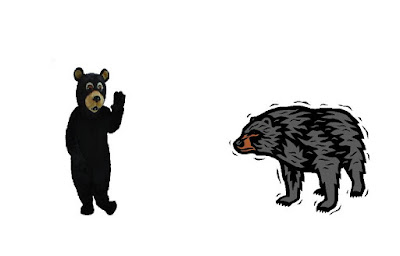Black Classification and evolution Bear
Black Bear (also known as the American Black Bear) is a medium-sized species of bears found inhabiting a number of forest habitats in North America. The black bear is not only the most widespread bear in the North American continent, but it is also the most numerous bear species in the world is believed to be twice the number of black bear individuals than all Other species combined. The black bear is also one of only two of the eight bear species not listed by IUCN as in danger that significant additional efforts for their versatility have led to healthy populations in much of their Remaining natural range of conservation (provided there is a good source of food). There are sixteen known Black Bear subspecies found in North America today, which are distinguished primarily by their colored size and coat along the area where they live.
Black Bear Anatomy and Appearance
Despite their name, black bears vary in color from black to dark red or brown, and maybe even a tan lighter in some areas. They have little thick fur covering their sturdy bodies and has a pointed snout, small eyes and ears larger and sharper than their brown bear parents. In addition to being much less, there are some other notable differences between the two species, whose black bear lacking the distinctive bump shoulders of their big cousins. They also have shorter legs and claws, making the black bear a much more agile climber than the brown bear, so that in areas where both are in the same spot, black bears are able to 'Escape the danger by digging their claws in the tree trunk and pulling up. Like all bear species, however, the black bear has an excellent sense of smell which is used to detect food and hearing and less developed vision because of their relatively small ears and eyes.
Black Bear Distribution and Habitat
Although the black bear is still prevalent in most of North America today, their historical range used to cover the continent, where they were found in every forest living area. Today they are found in northern Canada, the west and parts of the eastern United States, and northern Mexico. Provided that there is a forest habitat of some description of these incredibly adaptable animals will do their best to survive successfully, and they are actually found in a number of very different areas. Black bears are known to inhabit Mexico's hot, dry shrub and steam forests, hardwood swamps in the southeastern United States, the coniferous forests of Canada and Alaska and Barren tundra even further north. Despite local populations in some areas will be affected by the loss of their natural habitat, black bear elasticity means that populations in most areas are increasing.
Black Behavior Bear and lifestyle
The black bear is a largely solitary and nocturnal hunter who sometimes can tolerate the presence of other people when a series gather around an abundant food source. Black Bears spend most of their lives awake looking for food in the surrounding forest and have to eat huge amounts of plant material every day to ensure that they are building a decent life reserves of fat for the ' Next winter. When hostile winter conditions set in, black bears retire in a cave in a hollow tree or in a cave, where the semi-dormant during the cold months ahead. Although this is not worth the sleep their body temperature is that very little, it means they are able to wake up and go out looking for a snack to break their long sleep. In the warmer southern regions black bears do not care about Denning during the winter at all (except pregnant women), but in the northern regions of their range they can not come up to eight months later .
Black Bear Reproduction and Lifecycles
Male and female black bears will come briefly together to mate in the summer, after which they will be alone again, and both will begin to begin feasting to prepare for winter. After a gestation period lasts about seven months (although this includes a period of nearly five months of delayed implantation), the female black bear gives birth to one to five young in winter late in its cave. Small hairs are incredibly vulnerable and depend on the heat created in the heat cave of their mother's body to help them survive the first few days. Black bears stay with their mother until they are nearly two years old, learning the skills they need to survive on your own, and will even share her winter lair their first winter. After about a year and a half, the black bear woman looking back at mating and little ones are often finally scared away from her by increasingly aggressive mature men.

No comments:
Post a Comment